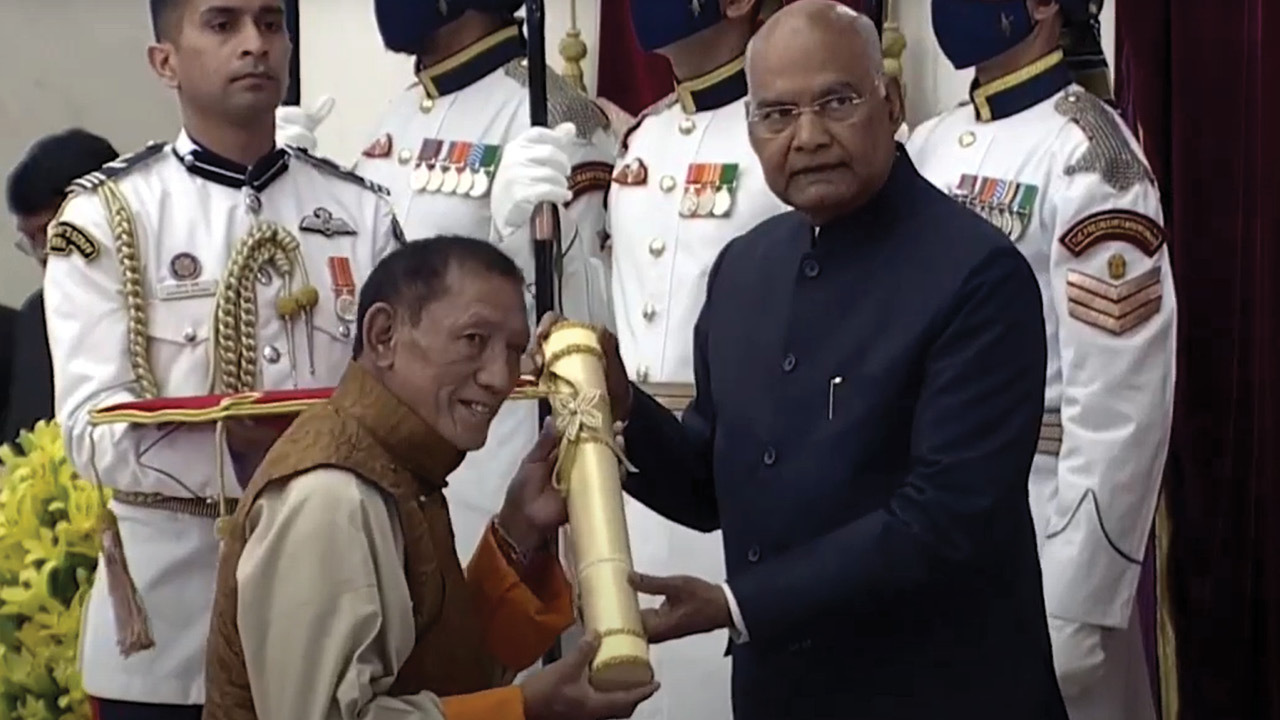Khandu Wangchuk Bhutia
Khandu Wangchuk Bhutia
Born: 1969
H.NO. Y II, A-7, Chaltlang Dingdi Veng
Aizawl, Mizoram – 796012
Padma Shri: 2021

About
Khandu Wangchuk Bhutia, a distinguished Thangka painter from Sikkim, India, has significantly contributed to preserving and promoting traditional Buddhist art. His dedication and mastery in this field have earned him numerous accolades, including the Padma Shri Award.
In 2022, the Government of India honoured Khandu Wangchuk Bhutia with the Padma Shri, the nation’s third-highest civilian award, in recognition of his distinguished service in the field of art. This accolade celebrated his expertise as an eminent Thangka painter specialising in traditional Buddhist paintings on cotton and silk.
Education
Born in 1959 in Sakyong, West Sikkim, Khandu Wangchuk Bhutia completed his early education at Government Senior Secondary Schools in Pelling and Namchi. Following his formal education, he embraced monastic life at the Pemayangtse Monastery. He apprenticed under renowned Thangka artists such as Dungsin Rimpoche, the Late Jigme Wangchuk Lama, the Late Phuntsok Sangpo, and the Late Sapa Acho, honing his skills in this intricate art form.
Hardships Faced
Embarking on a career in traditional arts like Thangka painting presents numerous challenges, including limited financial stability and the declining interest of younger generations in traditional crafts. Despite these obstacles, Khandu remained steadfast in his commitment to preserving this ancient art form, dedicating himself to practice and education to ensure its continuity.
Contributions that Brought About the Change
Khandu Wangchuk Bhutia’s contributions to Thangka painting are manifold:
- Artistic Excellence: Khandu’s Thangka paintings are renowned for their intricate detail and adherence to traditional techniques. His notable works include Buddhist murals at several monasteries, such as Pemayangtse Monastery (Pelling), Boomtar Tamang Gumpa (Namchi), Gnadak Monastery Old and New (Namchi), Allay Gumpa (Ravangla), and Tashi Choeling Monastery (Khechupalri). These murals beautify these sacred spaces and serve as educational tools depicting the life of the Buddha and various deities.
- Mentorship and Training: Understanding the importance of passing on traditional knowledge, Khandu has trained over 350 students from Sikkim in local handicrafts, including Thangka painting, wood carving, and carpet weaving. His mentorship has ensured that these traditional arts thrive among younger generations. Notably, his student Yeshey Sangpo Bhutia from Pelling received the National Award in 2008, highlighting the quality of Khandu’s tutelage.
- Cultural Ambassador: Khandu has represented Sikkim and India in various national and international seminars and exhibitions, showcasing the rich heritage of Thangka painting. His participation in events such as the India International Trade Fair in Delhi (2004), Surajkund Mela in Haryana (2006), Made in NorthEast India Fair in Bangkok, Thailand (2010), and Jeddah International Trade Fair in Saudi Arabia (2014) has brought global attention to this traditional art form.
- Preservation Efforts: Through his establishment, the Kanchendsonga Handicrafts Centre, registered in 1982, Khandu has created a platform for artisans to practice and promote traditional crafts. This center has been instrumental in preserving the cultural heritage of Sikkim and providing livelihoods to many artisans.
Before and After
Before Khandu’s extensive efforts, Thangka painting in Sikkim faced challenges such as diminishing interest and lack of formal training avenues. Artisans struggled to sustain themselves, and the art form risked fading into obscurity. Khandu’s dedication revitalised this traditional craft, leading to increased interest among the youth and recognition at national and international levels. The establishment of training centers and participation in global exhibitions have transformed Thangka painting into a viable profession, ensuring its preservation for future generations.
Achievements and Accolades
In addition to the Padma Shri, Khandu Wangchuk Bhutia’s achievements include:
- National Award (Handicrafts) in Thangka Painting (1981): This early recognition by the Ministry of Textiles, Government of India, highlighted his exceptional skills in Thangka painting.
- Bharat Excellence Award (2001): Conferred by the Friendship Forum of India, this award acknowledged his contributions to Indian art and culture.
- Kala Nidhi Award (2006): Presented at the Surajkund Fair in Haryana, this award recognised his excellence in traditional arts.
Khandu’s unwavering commitment to Thangka painting has preserved a vital aspect of Sikkim’s cultural heritage and inspired a new generation of artists. His life’s work is a testament to the enduring power of traditional art in contemporary society.

